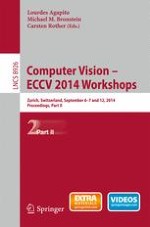The four-volume set LNCS 8925, 8926, 8927, and 8928 comprises the thoroughly refereed post-workshop proceedings of the Workshops that took place in conjunction with the 13th European Conference on Computer Vision, ECCV 2014, held in Zurich, Switzerland, in September 2014.
The 203 workshop papers were carefully reviewed and selected for inclusion in the proceedings. They where presented at workshops with the following themes: where computer vision meets art; computer vision in vehicle technology; spontaneous facial behavior analysis; consumer depth cameras for computer vision; "chalearn" looking at people: pose, recovery, action/interaction, gesture recognition; video event categorization, tagging and retrieval towards big data; computer vision with local binary pattern variants; visual object tracking challenge; computer vision + ontology applies cross-disciplinary technologies; visual perception of affordance and functional visual primitives for scene analysis; graphical models in computer vision; light fields for computer vision; computer vision for road scene understanding and autonomous driving; soft biometrics; transferring and adapting source knowledge in computer vision; surveillance and re-identification; color and photometry in computer vision; assistive computer vision and robotics; computer vision problems in plant phenotyping; and non-rigid shape analysis and deformable image alignment. Additionally, a panel discussion on video segmentation is included.
